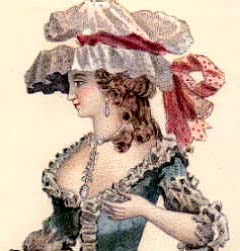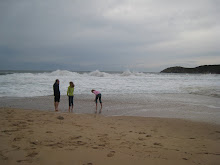Last week I was back in Paris with L. and G. We went to lunch, L. and I, at a creperie in the rue Servandoni. The creperie--and as far as I can tell, that is its only name--is the size of a smallish American living room, with tables and benches at the front, near the plate glass window and the door, and an open kitchen at the back, with the crepe-making griddle jutting out into the center of the narrow room. Madame, a sturdy woman in late middle age who looks like she would be equally comfortable standing in front of a grill at an American lunch counter, stands behind the griddle, spatula at the ready. Her ancient Jack Russell terrier either sleeps in his basket in the corner or patrols the tables looking for scraps. There are two steps up from the street into the dining room, but, due to a trick of the pavement, three steps down, and either Madame or the young woman waiting tables will remind you when you leave to watch out for the third step.
E., G., and I found this creperie on Easter day in 2005, and I keep going back to it every chance I get. After I stopped weeping daily about the outcome of the 2004 elections, I thought about what kind of excursion would make me really happy. And I thought of Paris. It had been nine years at that point since I had been in France; we had always talked about bringing the girls to France when they were of travelling age. It was time. We made airplane reservations and found an apartment to rent that was near where I had lived as a student and around the corner from the Eglise de Saint-Sulpice and its beautiful place. Thus we came to spend Easter vacation 2005 in the rue Servandoni.
We arrived at the apartment in the rue Servandoni on Easter weekend. The street is a block long, and connects Saint-Sulpice to the Luxembourg Gardens. That much I knew from my dog-earred Michelin Plan de Paris. But the instructive plaques on the street--you cannot walk more than a few feet in central Paris without coming across a plaque on a building, telling you about a historical character who was born or lived or died there--told a longer story. If you sit at the table in the window of the creperie, as L. and I did last week, and as we did last March, and as I did a year before that, and, again, with G. and E. on Easter day 2005, then when you look out the window and across the street you see a plaque that tells you that William Faulkner lived in that building for several months in 1925. If you are a southerner and a reader then, voila, you are connected: from Yoknapatawpha County to the City of Lights before you even order lunch.
Finish your crepe--I recommend the crepe parmentier, potatoes and cheese and an egg folded inside a warm crepe au sarrasin--and, minding the third step, walk out of the creperie and to the right, up towards Saint-Sulpice. Another plaque appears. William Faulkner's neighbor, two doors up and a century and change earlier, was the revolutionary Olympe de Gouges. De Gouges took her revolutionary brothers' bet and raised them, publishing in 1790 her proto-feminist Declaration of the Rights of Women to match the 1789 Declaration of the Rights of Man. Looked on as a novelty for a while, she eventually wore out her welcome and went to the guillotine, but not before she lived in the rue Servandoni for a while. She survives now in history books and dissertations--one of them mine. When I wrote about women in the French Revolution, her papers came across my desk in the Archives nationales across the Seine in the rue Rambuteau.
A little further up the street, and this time I saw a plaque I had missed before: Condorcet, one of the gentlest philosophers and scientists of the Enlightenment, and also one of the most unfortunate, had hidden in an apartment in that building for several months during the Revolution, after he had fallen from the good graces of the National Convention. My dissertation advisor--not a particularly nice or gentle man, but a good historian--wrote his first major book on Condorcet, and it sat on my shelves (reddish-orange binding, black letters) for years.
L. and I walked past these plaques and all their connections last weekend, and just as we passed the building where I stayed with my family nearly three years ago, my cell phone rang. It was C.: where was the cinnamon? L. and I had finished it off making pumpkin pie for our Provencal Thanksgiving. As we spoke on the phone L. and I turned the corner into the place Saint-Sulpice, where the booths for the Christmas market were already set up.
On my best days I feel part of a web of connections--connections of love and of the mind and of the past, my own and the world's--and it is so startling to me, so surprising, to find that web so dense on this little street in the Left Bank. The other day I found this, from Emily Dickinson, in my reading: To live is so startling it leaves little time for anything else. I am very busy.
Friday, December 7, 2007
Subscribe to:
Post Comments (Atom)






































No comments:
Post a Comment